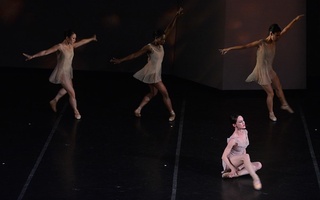{shortcode-ed1c3f8680e4f36571d7c0882e4246e476c3431b}
Not many ballet performances begin with a few dozen men in sweatshirts and sweatpants on stage. But John Neumeier’s “Third Symphony of Gustav Mahler: A Ballet”—Boston Ballet’s season opener, which premiered on Oct. 22—is not shy about parting from convention. The show, which will run until Nov. 1, is brought back to life this fall by choreographer Neumeier, who originally premiered the work as director of The Hamburg Ballet in 1975. More than 60 dancers perform in this ambitious piece, in which Neumeier divides Mahler’s complex, dramatic cacophony into six movements named “Yesterday,” “Summer,” “Autumn,” “Night,” “Angel,” and “What Love tells me.” While Neumeier’s interpretation of the “Third Symphony” loosely follows the storyline of one man, played by principal dancer Lasha Khozashvili, the choreographer ultimately discourages the audience from seeing the show as a slavish adherence to any one narrative. In this way, he creates a production that consistently pushes the boundaries of classical ballet.
As the first movement progresses, the sweats come off. The male dancers’ muscular bodies are soon stretched into both classical and unconventional ballet positions. Their battements, for example, are executed with such intensity as to highlight the athleticism of their movements. The men’s vigorous, synchronized motions evoke an almost marching band, or army-like, quality. No women appear on stage for the entire first movement. Gender dynamics, in fact, prove to be an important theme throughout the performance. The omission of women from the first movement makes the second all the more poignant: As ballerinas in pastel dresses slowly begin to pepper the stage, their femininity is emphasized. Meanwhile, a male dancer sits on stage, watching and creating a sensation of voyeurism, so that the audience perceives the female through the eyes of the male, as an observer. The romance and intimacy of the beautiful duet phrases later in the performance are heightened by this consciousness. These singular moments of stark gender imbalance that imagine the dancer as an observer speak to Neumeier’s ability to surprise the audience. He maintains his eccentric style throughout the show. “Night,” for example, begins with 10 minutes of music-free dancing, and over the course of the performance dancers form human pyramids four times.
The show’s simplicity counters the complexity of its movement and music. Costumes are minimal, coloring the dancers in brushstrokes of color while allowing their bodies to remain the focus. The stage is free from set, save for a lit backdrop of changing colors. This minimalism juxtaposes strongly with the intricacy of the music. In the pit, 78 musicians, 20 chorus members, and one vocal soloist, Sarah Pelletier, attempt to do justice to the dance’s muse, while the Boston Opera House’s soaring ceilings carry the dramatic, emotional notes of Mahler’s longest work.
In fact, this intense emotion, which Neumeier tries to capture in his dancers, ties the whole show together. The dancers’ faces alone are often enough to discern the sensations that their movements suggest. Khozashvili in particular seems to incarnate the desire, struggle, and yearning of his character. Neumeier’s choreography throws to the wind the often-restrained feeling of traditional ballets.
The Boston Ballet’s run of “Third Symphony of Gustav Mahler” fuses elements of ballet tradition in a modern framework with a subtlety that is not easily achieved. Neuemier is unique in encouraging the audience to acutely perceive gender relationships, and the emotional nature that this lends to the show does not soften the intricacy of the movement. The difficult choreography is not always easy to digest, but, in drawing on Mahler’s music, Neuemier does not intend to present the performance as such.
Read more in Arts
The Coffee Shop as Social SpaceRecommended Articles
-
Elizabeth C. Walker ’11Walker graces Harvard’s stages with ballet of a professional caliber.
-
Male Dancers Prominently Featured in BalletBoston Ballet's Fall Program highlights its male talent.
-
Harvard Ballet Company’s 'Jungle Book’ A Wild SuccessFrom the set design and music to the dancing, Harvard Ballet Company’s “The Jungle Book”—which opened in the Loeb Ex on April 3 and runs through April 11—is executed exceptionally well.
-
 José Mateo Ballet’s “Assault on the Senses” Blends Vigor With Grace
José Mateo Ballet’s “Assault on the Senses” Blends Vigor With Grace -
Portrait of an Artist: La’Toya Princess JacksonWith a background in ballet, songwriting, singing, and EDM, La’Toya Princess Jackson has done it all.The Harvard Crimson sat down with Jackson to discuss her artistic trajectory, her new show “Vanity Lane,” and inclusion on stage.













